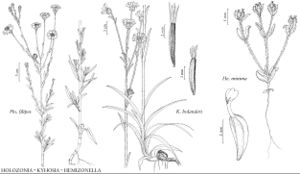Holozonia
Bull Torrey Bot. Club 9: 122. 1882.
| Taxon | Illustrator ⠉ | |
|---|---|---|
 | Holozonia filipes Kyhosia bolanderi Hemizonella minima | Yevonn Wilson-Ramsey Barbara Alongi Yevonn Wilson-Ramsey |
Perennials, 30–150 cm (rhizomatous). Stems (aerial) ± erect. Leaves mostly cauline; proximal opposite (basally connate), distal alternate; sessile; blades lanceolate to linear, margins entire, faces hirsute and (distal leaves) glandular-hirtellous (glands cupshaped). Heads radiate, borne singly or in loose, corymbiform arrays (peduncles filiform). Peduncular bracts: pit-glands, tack-glands, and/or spines 0. Involucres ± obconic or turbinate, 2–4+ mm diam. Receptacles flat to convex, glabrous or setulose, paleate (paleae falling, in 1 series between rays and discs, connate). Phyllaries 4–10 in 1 series (each mostly or wholly enveloping a ray ovary, ± lance-linear, herbaceous, abaxially hirsute, sometimes glandular-hirtellous, glands cupshaped). Ray-florets 4–10, pistillate, fertile; corollas whitish (abaxially purplish-veined). Disc-florets 9–28, functionally staminate; corollas white (pubescent), tubes shorter than funnelform throats, lobes 5, deltate (anthers ± dark purple; styles glabrous proximal to branches). Cypselae (black) obcompressed, ± clavate (basal attachments centered, apices beakless, areolae broadly cupulate, faces glabrous); pappi (rays) 0 or coroniform (0.1–0.3 mm), or (discs) 0 or (readily falling) of 1–5 subulate scales. x = 14.
Discussion
Species 1.
Holozonia has been treated as congeneric with Hemizonia and with Lagophylla. Like Lagophylla, Holozonia has functionally staminate disc florets, cup-shaped glands, and obcompressed cypselae, each completely or mostly invested by a phyllary. Additional morphologic considerations and biosystematic studies led W. C. Thompson (1983) to reject the hypothesis of a close relationship between Holozonia and Lagophylla. Molecular phylogenetic data are in keeping with a closer relationship of Holozonia to other continental tarweeds with white corollas and x = 14 (i.e., Blepharizonia and Hemizonia), than to Lagophylla (S. Carlquist et al. 2003).